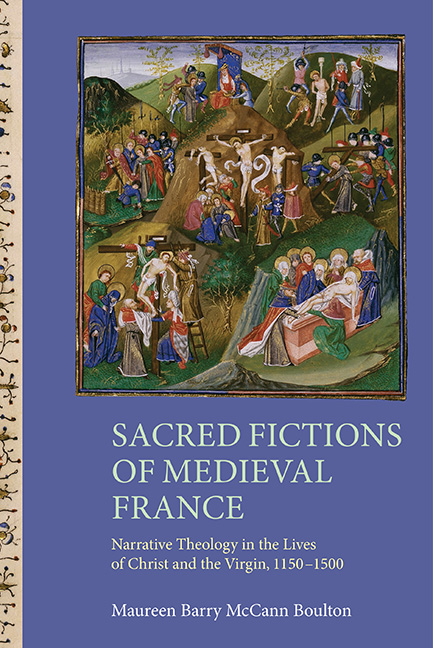 Sacred Fictions of Medieval France
Sacred Fictions of Medieval France Book contents
- Frontmatter
- Dedication
- Contents
- Acknowledgements
- Abbreviations
- Introduction
- 1 Sacred Romances: Genealogy, Lineage and Cyclicity
- 2 Sacred Epic and the Diffusion of Anti-Jewish Sentiment
- 3 Sacred Allegory and Meditation
- 4 Sacred Histories: the Chronicles of Jean d’Outremeuse and Jean Mansel
- 5 Sacred Imaginations: Lives of Christ and the Virgin in Texts of A ffective Devotion
- Epilogue: Lives and Afterlives
- Appendix: Lists of Manuscripts by Chapter
- Bibliography
- Index
Epilogue: Lives and Afterlives
Published online by Cambridge University Press: 11 June 2021
- Frontmatter
- Dedication
- Contents
- Acknowledgements
- Abbreviations
- Introduction
- 1 Sacred Romances: Genealogy, Lineage and Cyclicity
- 2 Sacred Epic and the Diffusion of Anti-Jewish Sentiment
- 3 Sacred Allegory and Meditation
- 4 Sacred Histories: the Chronicles of Jean d’Outremeuse and Jean Mansel
- 5 Sacred Imaginations: Lives of Christ and the Virgin in Texts of A ffective Devotion
- Epilogue: Lives and Afterlives
- Appendix: Lists of Manuscripts by Chapter
- Bibliography
- Index
Summary
As the previous chapters of this book have shown, vernacular lives of Christ and Mary achieved a broad circulation in France from the twelfth century onwards, and were cast in many different narrative forms. Their popularity is clear from the numerous individual narratives that were composed, as well as from the extensive circulation of many of those narratives, and is a result of the effectiveness of narrative theology. The earliest French lives of Christ and the Virgin appeared in the twelfth century, with the poems of Wace and Herman de Valenciennes, who adopted the forms of romance and epic, respectively. Both of these writers used their narratives to convey serious Marian doctrines about Mary's Conception and Assumption, as well as about the importance of virginity (Wace), and the dynamic of salvation (Herman). For the relatively unsophisticated writers of thirteenth-century sacred romances, by contrast, the form allowed them to enter into competition with secular romances by substituting what they considered a more wholesome form of entertainment. The doctrinal content of these romances was thin – consisting largely of the demonstration of Christ's dual nature as God and man through accounts of miracles – but they also reinforced cultural prejudices against Jews. Writers like John of Howden, Matfre Ermengaud, Guillaume de Digulleville, and Jean Henry exploited the possibilities of allegory in a variety of ways to provide introductions to meditative prayer for readers ranging from royalty to merchants. In the fifteenth century, translations of Latin works into French made the meditative works of important theologians (Jean Gerson, Michael of Massa, Ludolph of Saxony) available to non-clerical readers. The same century also saw the composition of original works of devotion by lay writers like Christine de Pizan, Martial d’Auvergne, and Gabrielle de Bourbon.
As can be seen from the lengthy lists of manuscripts in the Appendix, many of these works enjoyed a considerable circulation. The twelfth-century poems of Wace and Herman de Valenciennes continued to be copied over a period of two hundred years, well into the fourteenth century. The next generation of poems on the same themes – the Histoire de Marie et de Jésus and the Passion des Jongleurs and their associated cycles – seems to date from the first half of the thirteenth century, and these poems in their turn continued to be copied into the fifteenth century.
- Type
- Chapter
- Information
- Sacred Fictions of Medieval FranceNarrative Theology in the Lives of Christ and the Virgin, 1150–1500, pp. 285 - 298Publisher: Boydell & BrewerPrint publication year: 2015
